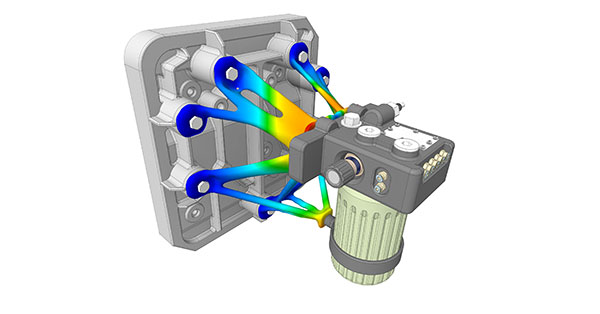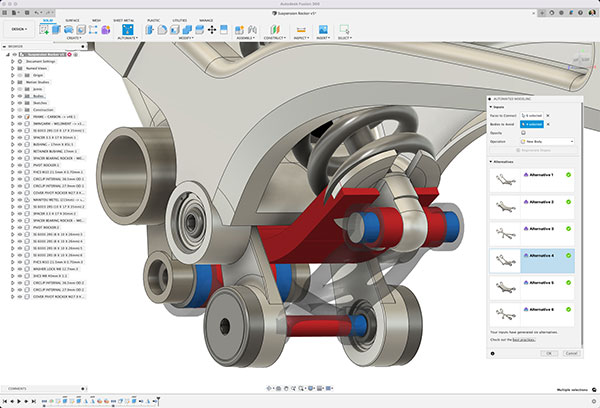
Many design software makers consider generative design the prelude to machine learning or AI-powered simulation. Shown here are generative design features from Ansys simulation software. Image courtesy of Ansys.
Latest News
December 1, 2023
The term “AI-powered,” like its predecessor “generative,” is becoming an instrumental part of design and engineering software. Researchers may still disagree on whether the level of automation in a piece of software is sufficiently self-aware to be called AI (artificial intelligence), but the so-called AI-powered tools will soon become the norm. It’s reflected in the strategies adopted by the leading developers.
Stan Przybylinski, vice president of analyst firm CIMdata, remarks, “AI has long enabled generative design, and isn’t it interesting that the word ‘generative’ re-emerged in the AI context with ‘generative AI’ and ChatGPT?”
“Quite literally on the day I joined Ansys five years ago, I told my CEO that AI or ML (machine learning) is one of the most important technologies Ansys should be investing in, and he agreed,” recalls Prith Banerjee, chief technology officer at Ansys. “So in 2018, we started investing in it, specifically to explore opportunities in two areas: can AI or ML make simulation faster? Can it make simulation easier to use?”
“We see AI as an evolution of generative design. We’ve been investing in generative design for 10 years or more,” says Stephen Hooper, vice president of Design and Manufacturing at Autodesk. “One area that we think AI is particularly interesting is [for] interpreting natural language input. Whether it’s in simulation or CAM (computer-aided manufacturing), we see opportunities to use large language models to define complex problems, interpret them and then set them up.”
For some firms, the investment is already bearing fruits as tangible, usable tools, though not all are commercially available yet. These are the early harvests of the AI Spring.
This Is Your AI Assistant. How Can I Help?
In July 2023, Ansys launched AnsysGPT, a virtual assistant trained on natural language processing. The company announced, “Developed using state-of-the-art ChatGPT technology available via the Microsoft Azure OpenAI Service, AnsysGPT uses well-sourced Ansys public data to answer technical questions concerning Ansys products, relevant physics and engineering topics within one comprehensive tool.”
“Essentially, it’s a natural language interface to the kind of questions that normally our field application engineers would respond to,” says Banerjee. “Now we’re using AnsysGPT to answer them, because AI is really good at looking at all published training material and providing a very quick and accurate resolution to an issue. In the very near future, we will have natural language interfaces to all our products.”
From text input, it’s a small step to voice command based on natural language. Banerjee reveals his R&D team is exploring voice and text input options. He points out that in general computing, “the voice-to-text conversion is already solved” but the challenge, he said, is to solve the “text-to-simulation” issue—extracting computable parameters, loads and boundary conditions from a scenario described in everyday language.
Does Your Software Speak FEA?
The challenge comes from the difference in how terms like pressure, load and surface are used in everyday conversation vs. how they’re used in engineering simulation. For example, a student revealing “I’m under a lot of pressure” and an engineer stating “this joint is under a lot of pressure” are expressing two different ideas. The first is subjective and emotional; the second is computable simulation data, if a number can be assigned.
An advocate of graphics processing unit (GPU)-accelerated AI workloads, NVIDIA offers an AI Room Generator Extension (available from GitHub) for Omniverse users. The application is powered by NVIDIA DeepSearch and GPT 4. When creating environments such as warehouses and reception areas, instead of dragging and dropping items from a library, users can use text prompts, such as “add common items found in a warehouse/reception area.”
“The extension combines the prompt provided by the user (for example, “fill the defined space with classic art deco furniture”) with a system prompt provided to GPT-4 that provides more context to the large language model on how to process the request,” explains Mario Viviani, developer relationship manager for Omniverse. “So the system prompt may be as complex as, for example, ‘You are an area generator expert. Given an area of a certain size, generate a list of items appropriate to that area, in the right place and with representative materials.’”
Many AI tools are expected to start out as pretrained, ready-to-use programs from the vendors, but because good design decisions and best practices are tied to specific industries, individual workflows and even in-house knowledge, more vendors are looking to offer a way for the users to train or refine the AI algorithms using proprietary data.
“Autodesk has a branch called Autodesk GPT. It’s based on ChatGPT but it’s proprietary to us,” explains Hooper. “Think of it as a large language model, plus the differential data. For us, that differential data is Autodesk data. That differential is what allows us to train the ML model on our APIs [application programming interfaces] and our software’s functions unique to us.” In the long run, Hooper envisions creating APIs that allow Autodesk customers to use their own proprietary data for ML training. “If the algorithm is trained on your historical data, it understands your design cues, styling cues and brand identity,” he says.
Hooper doesn’t think the infusion of natural language input will spell the end of dialog boxes and menu bars. “I think software will have multiple input modes,” he says—“a combination of text, images and 3D models.”
Personalized AI Algorithms
Whereas Ansys is using AI for text-based tech support, some are considering personified AI avatars for providing basic training. In October, the VR software developer Campfire 3D released a collaboration app for Meta Quest, a consumer-friendly VR headset. Part of the software is the AI-driven virtual assistant, named Spark. “When we showed Spark to the customers, they often asked, ‘Can we use Spark to provide software training to our employees?’” recalls Jay Wright, Campfire co-founder and CEO.
Currently, Spark’s interactivity is limited to performing scripted speeches and action sequences. But Wright envisions enabling ChatGPT-style natural language processing and even APIs for the customers to train Spark with their proprietary data, allowing users to develop work instructions and training materials tailored with their individual sectors.
In September, electronics CAD software developer Zuken unveiled a new tool dubbed AIPR (Autonomous Intelligent Place and Route), available to customers using its flagship printed circuit board design software, CR-8000.
According to Kyle Miller, research and product manager at Zuken, AI-optimized PCB layout tends to be cleaner, simpler, with fewer clashes, because the software could process design hierarchy and signal clusters much better than human experts.
Though currently the AIPR is trained on Zuken’s data and industry best practices, the company’s vision is to offer a tool that Zuken’s customers can use to apply machine learning to their own library. The company calls it the Dynamic Brain, which “learns from your PCB designers, utilizing past design examples and integrating them into AI algorithms,” says Miller.
Can AI Develop Good Instincts?
One of the most time-consuming aspects of simulation is calculating the topological deformations in response to stresses and loads. The task usually involves full physics simulation. But the use of AI may offer a simpler, faster way to accomplish the same task.
“In a research project, we took thousands of 2D and 3D shapes and ran them through our CFD solvers,” recalls Hooper. “After a while, the trained software was able to predict the CFD results purely based on the input shapes, without running simulation.”
It’s similar to what veteran CFD experts are able to do, based on their experience. In humans, it might be called “intuition,” but in AI and ML, such wisdom can be distilled as an algorithm. This method may reduce the amount of computation drastically in CFD. The same approach may also be applied to develop algorithms capable of predicting heat transfer, structural deformation and other types of simulation.
Hooper cautions that this method “is not supposed to deliver accurate simulation results, but if you’re a designer trying out concepts, it can help you settle on the right branch of design options.”
Revealing a similar approach, Jing Bi, SIMULIA Technology senior manager at Dassault Systèmes, says, “We are currently developing machine learning tools to help accelerate design space exploration. When optimizing a product design, there are typically numerous variables that can be altered: for example, shape and size in all three dimensions as well as material properties and different load conditions. Using traditional physics-based simulation (such as finite elements, finite volumes, etc.) to validate every combination would be very time-consuming. Machine learning can speed up this process massively.”
In October, Ansys announced Ansys SimAI, a cloud-enabled, physics-neutral platform for simulation. “Ansys SimAI will allow users to first train an AI model using simulation results and then make predictively accurate analogous designs. Unlike methods where users had to describe their designs using a set of geometric parameters, Ansys SimAI will use the shape of a design as the input to facilitate expansive design exploration. This enables leveraging existing simulation results for training, even if the structure of the shapes is inconsistent,” the company wrote.
While CFD users may not be familiar with the term “Little’s law,” many factory operators live by it. Mark Spearman, technical director of the Project Production Institute (projectproduction.org), defines it as the principle that “describes the relationship between the work-in-process, cycle time and throughput for an individual operation, and also for an entire production system composed of a set of operations.”
On October 23, Autodesk signed an agreement to acquire FlexSim, giving it the technology that simulates factory-floor operations and logistics centers. The acquisition is expected to bolster Autodesk’s factory-management portfolio.
“In factory operations, we can find out the mean arrival time of raw materials, with a standard deviation. We can also obtain the mean processing time,” explains Hooper. “Based on these two factors, you can pretty much model the entire factory flow. So if you also have the models of your machines in software, you can lay out the model of the factory.

In Autodesk products AI-like features began appearing as generative design. Shown here is a tool called Automated Modeling in Autodesk Fusion 360. Image courtesy of Autodesk.
Applying AI to this process would lead to automatic factory layout optimization, Hooper points out. The tool will most likely fit into the workflows served by Autodesk products such as Autodesk Revit (for architecture), Navisworks, Autodesk Construction Cloud and Autodesk Tandem (for digital twins).
“We think simulation still has room to grow,” CIMdata’s Przybylinski says. “Electrification, autonomous and other advanced technologies require a system of systems approach in their definition, creation and continued use. If anything, simulation is going to become more important.”
More Ansys Coverage
More Autodesk Coverage
More CIMdata Coverage
More Dassault Systemes Coverage

Subscribe to our FREE magazine, FREE email newsletters or both!
Latest News
About the Author
Kenneth Wong is Digital Engineering’s resident blogger and senior editor. Email him at [email protected] or share your thoughts on this article at digitaleng.news/facebook.
Follow DE







